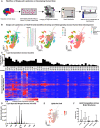Identification of Lipid Heterogeneity and Diversity in the Developing Human Brain
- PMID: 34977897
- PMCID: PMC8717369
- DOI: 10.1021/jacsau.1c00393
Identification of Lipid Heterogeneity and Diversity in the Developing Human Brain
Abstract
The lipidome is currently understudied but fundamental to life. Within the brain, little is known about cell-type lipid heterogeneity, and even less is known about cell-to-cell lipid diversity because it is difficult to study the lipids within individual cells. Here, we used single-cell mass spectrometry-based protocols to profile the lipidomes of 154 910 single cells across ten individuals consisting of five developmental ages and five brain regions, resulting in a unique lipid atlas available via a web browser of the developing human brain. From these data, we identify differentially expressed lipids across brain structures, cortical areas, and developmental ages. We inferred lipid profiles of several major cell types from this data set and additionally detected putative cell-type specific lipids. This data set will enable further interrogation of the developing human brain lipidome.
© 2021 The Authors. Published by American Chemical Society.
Conflict of interest statement
The authors declare no competing financial interest.
Figures




Similar articles
-
The LUX Score: A Metric for Lipidome Homology.PLoS Comput Biol. 2015 Sep 22;11(9):e1004511. doi: 10.1371/journal.pcbi.1004511. eCollection 2015. PLoS Comput Biol. 2015. PMID: 26393792 Free PMC article.
-
Effects of diet and development on the Drosophila lipidome.Mol Syst Biol. 2012;8:600. doi: 10.1038/msb.2012.29. Mol Syst Biol. 2012. PMID: 22864382 Free PMC article.
-
Shotgun mass spectrometry-based lipid profiling identifies and distinguishes between chronic inflammatory diseases.EBioMedicine. 2021 Aug;70:103504. doi: 10.1016/j.ebiom.2021.103504. Epub 2021 Jul 24. EBioMedicine. 2021. PMID: 34311325 Free PMC article.
-
Lipidomics: coming to grips with lipid diversity.Nat Rev Mol Cell Biol. 2010 Aug;11(8):593-8. doi: 10.1038/nrm2934. Epub 2010 Jul 7. Nat Rev Mol Cell Biol. 2010. PMID: 20606693 Review.
-
Avanti lipid tools: connecting lipids, technology, and cell biology.Biochim Biophys Acta. 2014 Aug;1841(8):1038-48. doi: 10.1016/j.bbalip.2014.05.008. Biochim Biophys Acta. 2014. PMID: 24954118 Review.
Cited by
-
Data-Driven and Machine Learning-Based Framework for Image-Guided Single-Cell Mass Spectrometry.J Proteome Res. 2023 Feb 3;22(2):491-500. doi: 10.1021/acs.jproteome.2c00714. Epub 2023 Jan 25. J Proteome Res. 2023. PMID: 36695570 Free PMC article.
-
Chemical tagging mass spectrometry: an approach for single-cell omics.Anal Bioanal Chem. 2023 Nov;415(28):6901-6913. doi: 10.1007/s00216-023-04850-0. Epub 2023 Jul 19. Anal Bioanal Chem. 2023. PMID: 37466681 Free PMC article. Review.
-
Integrated Metabolomics and Lipidomics Reveal High Accumulation of Glycerophospholipids in Human Astrocytes under the Lipotoxic Effect of Palmitic Acid and Tibolone Protection.Int J Mol Sci. 2022 Feb 23;23(5):2474. doi: 10.3390/ijms23052474. Int J Mol Sci. 2022. PMID: 35269616 Free PMC article.
-
Studying the Effects of Dissolved Noble Gases and High Hydrostatic Pressure on the Spherical DOPC Bilayer Using Molecular Dynamic Simulations.Membranes (Basel). 2024 Apr 12;14(4):89. doi: 10.3390/membranes14040089. Membranes (Basel). 2024. PMID: 38668117 Free PMC article.
-
Region-specific quantitation of glycosphingolipids in the elderly human brain with Nanoflow MEA Chip Q/ToF mass spectrometry.Glycobiology. 2025 Apr 23;35(6):cwaf022. doi: 10.1093/glycob/cwaf022. Glycobiology. 2025. PMID: 40207879 Free PMC article.
References
-
- Marsh D.; Horvath L. I.; Swamy M. J.; Mantripragada S.; Kleinschmidt J. H. Interaction of membrane-spanning proteins with peripheral and lipid-anchored membrane proteins: perspectives from protein-lipid interactions (Review). Mol. Membr. Biol. 2002, 19 (4), 247–55. 10.1080/09687680210162419. - DOI - PubMed
